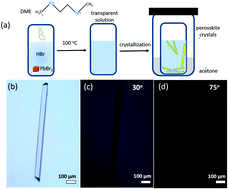High charge carrier mobility in solution processed one-dimensional lead halide perovskite single crystals and their application as photodetectors†
Abstract
Organic inorganic hybrid metal halide perovskites have emerged as promising candidates for photovoltaics and light-emitting diodes. Recently, interest has been growing in the properties of low-dimensional metal halide perovskites, and one-dimensional versions with strong quantum confinement have demonstrated highly efficient broadband luminescence. Nevertheless, the charge transport mechanism in these low dimensional perovskites remains unclear. In this work, we characterised the charge mobility in one-dimensional perovskite single crystals using a space charge limited current method. Temperature dependent charge mobility measurements indicated that localized polarons at high temperature are replaced by delocalized polarons at low temperature with extended states in the polaronic band. A minimum mobility of 4.51 cm2 V−1 s−1 was measured at room temperature. UV photodetectors based on these crystals show an ultrahigh photoresponsivity of 132.3 A W−1. These findings show the promise of high mobility low dimensional perovskite materials for optoelectronic applications.



 Please wait while we load your content...
Please wait while we load your content...